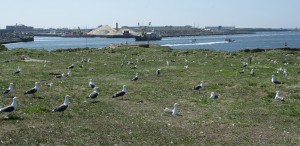The tracking study is part of an ongoing collaboration between UvA (Dr. Judy Shamoun-Baranes) and the NIOZ (Dr. Kees Camphuysen). The study is being conducted within the project “Interactions between birds and offshore wind farms: drivers, consequences and tools for mitigation” funded by NWO Applied and Engineering Sciences Open Technology Programme, Rijkswaterstaat and Gemini windpark. The tracking study will provide complementary information on the movement patterns of gulls breeding along the North Sea coast, with similar objectives to the studies conducted on Texel and Schiermonnikoog. The main aim is to identify intrinsic and external drivers of movement from fine scale flight behaviour to seasonal migrations. While adult gulls from other colonies have been tracked since 2008, little is still known about the daily movements and flight behaviour of juveniles and how this differs from adults. This study will contribute to our knowledge on how juvenile birds develop their foraging and migration strategies and how their flight behaviour differs from adults.
Within the scope of the project we are especially interested in fine scale flight behaviour at sea. Forteiland is particularly interesting in this respect as it is relatively close to several wind parks in the North Sea. Enabled by the design of the tracking system, the UvA-BiTS system will automatically switch to high resolution measurements over the North Sea, measuring speed, altitude, location and tri-axial acceleration to identify behaviour, every 3 seconds.
If you are following birds on the website or in the field, here are the codes for birds tracked in 2019
